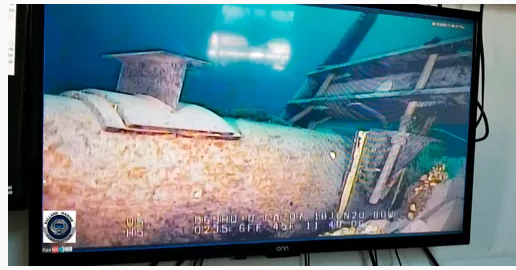Enbridge-contracted vessels may be to blame for recent damage to the east leg of the Line 5 pipeline in the Straits of Mackinac, according to a report written by the Canadian pipeline giant.
Based on vessel tracking and marine experts, Enbridge narrowed down to five the list of “small to moderately-sized” vessels that could have dragged a cable in a north and south direction over Line 5. The cable scraped the east leg and damaging an anchor support holding up the segment.
Four of the five boats are Enbridge-contracted vessels.
Enbridge interviewed the operators of its contracted vessels, which were in the water to perform maintenance and activities related to the Great Lakes Tunnel Project, and obtained their logs, procedures and plans, according to a report submitted Wednesday to the state and the Pipeline and Hazardous Materials Safety Administration.
In interviews, the vessel operators weren’t aware of an incident that would have created the damage, according to the report.
“As of now we can’t rule out their involvement,” Enbridge spokesman Ryan Duffy said Thursday. “Enbridge will continue to investigate, but it may not be possible to definitively identify the specific vessel that caused the incident.”
Line 5, which transports up to 540,000 barrels a day of light crude oil, light synthetic crude and natural gas liquids, has been the subject of a years-long dispute over a possible rupture of the 67-year-old pipeline in the Great Lakes.
Enbridge is in the process of constructing a tunnel to hold the pipeline, but has encountered headwinds from state regulators and leaders worried about the line’s continued presence in the Straits.
The state still is reviewing the 45-page report that summarizes the company’s investigation into four separate areas of potential impact found in May and June inspections, all of which the company believes to have been caused by at least two “small to moderately-sized” ships dragging some sort of cable.
The company maintains the damage done to the pipeline was not enough to threaten the safe operation of either segment. Under court order, Enbridge currently is only able to operate the west segment until federal regulators deem the east leg safe.
“None of these observations suggest any impairment of the safety of the lines,” the report said.
Nonetheless, Enbridge said the incident prompted the company to take further measures against damage to the pipeline from smaller vessels. It is now requiring at least one on-water patrol boat 24 hours a day to monitor commercial vessels for unsecured cables or anchors.
In May 2019, Michigan Gov. Gretchen Whitmer ordered state officials to issue rules requiring large vessels to verify that no anchors are dragging before passing through the Straits of Mackinac to prevent damage to the pipelines.
The governor’s directive to the state Department of Natural Resources followed an April 2018 anchor strike that severed two underwater transmission lines and dented the east and west fuel pipeline spans of Line 5. Whitmer asked the U.S. Coast Guard to hold foreign vessels to the same standards.
Inspection report
Earlier this year, during a May 20 routine inspection, a portion of the east segment was found to be scraped and then, less than a month later on June 18, the company found a nearby anchor support on the east segment was also damaged.
A day later, on June 19, Enbridge found drag marks on the bottom lands next to a portion of the west and east segment in which “biota” or calcifications on the line appeared to be disturbed or rubbed off. The report refers to the June 19 findings as “features of interest.”
The damage discovered May 20 and June 18 is believed to have occurred in a separate incident from the June 19 findings. The vessel that damaged the east leg is believed to have been moving north-south, while the vessel that scraped biota in a line across the west and east leg is believed to have been moving east-west.
None of the damage is believed to have been caused by “a large vessel dragging its anchor,” as was the case with the April 2018 damage to the pipeline.
But it’s possible a small to moderately sized vessel dragging a cable, perhaps with a small anchor or object at the end, was at fault, the report said.
“Due to the minimal depth of the light track, along with the fact that only biota was removed from the pipelines, it is believed that the light mark in the lakebed was the result of a dangling cable or a small vessel anchor; a heavy ship anchor would have left a deeper impression in the clay lake bed,” the report said.
The at-fault vessel tied to the east segment damages found May 20 and June 18 could be narrowed down to one of 13 vessels anchored within 500 feet of the pipelines whose “cable became entangled around and pulled the pipeline support” while moving in a north-south direction, according to the report. Those 13 vessels were narrowed to five, four of which are contracted by Enbridge.
The company is still reviewing the logs of those ships and has made a public records request to the U.S. Coast Guard for a list of any vessel that requested to anchor in the Straits.
The east leg damage discovered May 20 and June 18 is believed to have occurred between June 27, 2019 and May 20, 2020, while the “features of interest” discovered on the east and west leg June 19 are believed to have occurred between September 2018 and fall 2019.
Between May 20 and June 7, Enbridge inspected and repaired the east leg by buffing scratches and making coating repairs.
Engineers concluded the damaged anchor support — believed to have been cause by roughly 2,600 pounds of force — does not need to be replaced before the pipeline resumes operation because the lack of a support there “does not impair the integrity of the pipeline,” the report said.
Nonetheless, the company removed the damaged support and has applied to the state and U.S. Army Corps of Engineers to install a new pipeline support near the damaged one.
Separate from that damage, the only disturbances to or “features of interest” on the lines consisted of “disturbed biota and calcerous deposits,” the report said.
Battles with state, in court
The report comes as Enbridge awaits a decision from federal regulators on the safety of the line, a decision that Circuit Judge James Jamo will use in deciding whether to allow Enbridge to reopen the east segment. The judge allowed the reopening of the west segment of the pipeline July 1 to perform an inline inspection.
Enbridge released a report on the status of the west line July 8, noting that an analyses by energy technology company Baker Hughes found there were no dents in the line nor was there external or internal metal loss.
Separately, the state last week sought a written pledge from Enbridge to cover costs that would arise if oil were to lead from its dual pipelines, roughly $900 million of liability insurances and $1.88 billion in additional assets.
A study last year commissioned by the state alleged an existing agreement between the state and Enbridge for the company to pay up to $1.8 billion for a spill was not sufficient to ensure Enbridge’s cooperation.
Enbridge rejected the report and said recent agreements with the state required $1.8 billion in coverage and were sufficient to enforce such a promise.
After a second request from Department of Natural Resources Director Dan Eichinger this week for a new written agreement Enbridge said it was ready to “walk you and others through the financial assurances that have been agreed to.”
Attorney General Dana Nessel moved to close the pipeline last year but was stopped by the Ingham court. Separately, the Michigan Court of Appeals unanimously upheld the constitutionality of a 2018 law that allows Enbridge to build an underground tunnel to house the pipelines beneath the Straits.
Nessel again asked in June to have the pipeline closed temporarily, filing an addendum to her existing suit in Ingham County, after Enbridge on June 18 reported damage to the east leg anchor support and west leg segment.
Based on drag marks on the lake bottom, an Enbridge lawyer said the company believes the damage to the west leg was probably done by a vessel dragging an object — likely a thin, light item such as a cable — moving east to west across the straits. But damage to the east line anchor support may have been caused by a vessel dragging something parallel to the line.
- Laker Men’s Basketball Handle Kuyper 88-55 - December 23, 2024
- MYWAY Sault Bridge Brawl & NEMWA Regional Results - February 22, 2024
- Crawford County Prosecutor clears State Trooper in the fatal shooting of man earlier this month - February 23, 2023




